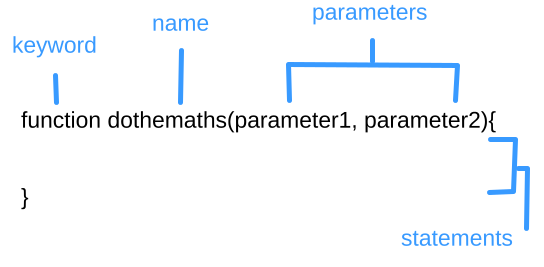reading-notes
Course 102, Entry 7: Programming with JavaScript
Control Flow
Control flow is the order in which code is executed. A computer’s flow starts off being from top to bottom, but will change what is read and where if it comes across specific commands. This happens a lot.
A simple example of a switch would be an if-else (conditional statement). Once the first line of the conditional is met, the next options are irrelevant. Thus, the computer can skip the next lines in the conditional statement and move on.
JavaScript Functions
Components of a Function Definition
In JavaScript, a function is a block of code that is set to run certain, localized (within the block), code statements.
Calling a function, or invoking it, is to execute a function.
A function is composed of the keyword, the name of the function, the parameters which are within parentheses (dependent on the function workings), each separated by commas, and then the lines of code, statements, within curly brackets.
Functions, like other code, can also be assigned to variables. However, when assigning, there are some important considerations. Remember, when defining a variable in JavaScript, either let or const needs to be used. There are workarounds to this though, such as creating a new variable within HTML instead.

Another important part of a function is the return statement. The return statement is written within the code curly brackets; It is what allows code to exit the function and continue to be used elsewhere.
Components of a Call Function Command
If the function is to be invoked, the function name must be typed out followed by open and closed parenthesis. The open and closed parentheses together are known as the operator. Without the operator, one is just calling the object. If the function by definition has parameter components, then values need to be fed into the function, replacing the places of the parameters. Once the values enter the function into the lines of code, these values are then known as arguments. The discerning difference between parameters and arguments is that parameters are in the function definition, while arguments are values that have entered the statements when the function is being called.
Functions have a lot of neat uses. And while they aren’t mandatory to execute code, they make it a whole lot easier and more useful. The key advantage of computers is their efficiency. Less code can be used and code can be repurposed.
JavaScript Operators
Arithmetic Operators
Operator Description
+ Addition
- Subtraction
* Multiplication
** Exponentiation (ES2016)
/ Division
% Modulus (Division Remainder)
++ Increment
-- Decrement
Note, increment and decrement operators will still work in a loop, even if entered into console.log command.
Assignment Operators
Operator Example Same As
= x = y x = y
+= x += y x = x + y
-= x -= y x = x - y
*= x *= y x = x * y
/= x /= y x = x / y
%= x %= y x = x % y
**= x **= y x = x ** y
Comparison Operators
Operator Description
== equal to
=== equal value and equal type
!= not equal
!== not equal value or not equal type
> greater than
< less than
>= greater than or equal to
<= less than or equal to
? ternary operator
Logical Operators
Operator Description
&& logical and
|| logical or
! logical not
Type Operators
Operator Description
typeof Returns the type of a variable
instanceof Returns true if an object is an instance of an object type
Bitwise Operators
Operator Description Example Same as Result Decimal
& AND 5 & 1 0101 & 0001 0001 1
| OR 5 | 1 0101 | 0001 0101 5
~ NOT ~ 5 ~0101 1010 10
^ XOR 5 ^ 1 0101 ^ 0001 0100 4
<< left shift 5 << 1 0101 << 1 1010 10
>> right shift 5 >> 1 0101 >> 1 0010 2
>>> unsigned right shift 5 >>> 1 0101 >>> 1 0010 2
Bitwise Operators Explained
Operator Name Description
& AND Sets each bit to 1 if both bits are 1
| OR Sets each bit to 1 if one of two bits is 1
^ XOR Sets each bit to 1 if only one of two bits is 1
~ NOT Inverts all the bits
<< Zero fill left shift Shifts left by pushing zeros in from the right and let the leftmost bits fall off
>> Signed right shift Shifts right by pushing copies of the leftmost bit in from the left, and let the rightmost bits fall off
>>> Zero fill right shift Shifts right by pushing zeros in from the left, and let the rightmost bits fall off
See W2 Schools for a more detailed explanation.
String Operators
Operator Example Output Result
+ text1 = "big" + "deal" big deal
+= text1 = "no"
text1 += "problem" no problem
Ternary Operators
Syntax:
condition ? val1 : val2
If condition is True - val1
If condition is False - val2
Comma Operator
The comma operator is a rare one to use. But it can be useful when trying to run a loop with multiple variables at the same time. Don’t use this otherwise, as two separate statements normally can be used.
Example:
const x = [0, 1, 2, 3, 4, 5, 6, 7, 8, 9];
const a = [x, x, x, x, x];
for (let i = 0, j = 9; i <= j; i++, j--) {
// ^
console.log(`a[${i}][${j}]= ${a[i][j]}`);
}
Unary Operators
An operation with just one operand.
Other Operators
Some other operators to be used later are delete, void, in, this new, and super.